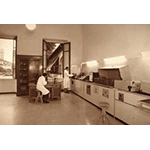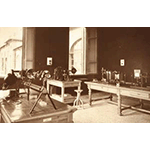Stabilimento Chimico Farmaceutico Militare [Military Pharmaceutical Chemical Works]
The origins of the Institute date from 1832, under the reign of Charles Albert of Savoy. In 1853 a Military Pharmacy Deposit was established in Turin, with a General Chemical Pharmaceutical Laboratory annexed to it. After World War I, the Laboratory was moved to Florence where, in 1931, under the name of Military Pharmaceutical Chemical Institute, it began production. With the outbreak of World War II, production ceased due to the compulsory order to move all machinery to Germany. At the end of the war, the machinery was brought back to the Institute, which then resumed its activity. In 1977 the name of the Institute was changed to Military Pharmaceutical Chemical Works. From its vast production, elixir of cinchona became one of the most famous preparations, made according to the definitive formula that appears in the military pharmacopeia of 1877. Starting in 1903, the Institute began to produce quinine for the State as well.
Still active, the plant conserves its pharmaceutical furnishings and a collection of medical-pharmaceutical instruments. These include apparatus for analyses dating from the 20th century (polarimeters, microscopes, spectroscopes, distillaters, scales), production machines and medical material for mobilisation (emergency first-aid kits and surgical instruments).
Its library possesses, in addition to pharmaceutical codexes and treatises, an anonymous nineteenth-century herbarium consisting of 21 volumes bound in cardboard containing around 30,000 specimens in a good state of conservation.
****************************
Texts by Francesca Carletti
English translation by Catherine Frost
Last update 15/feb/2008





